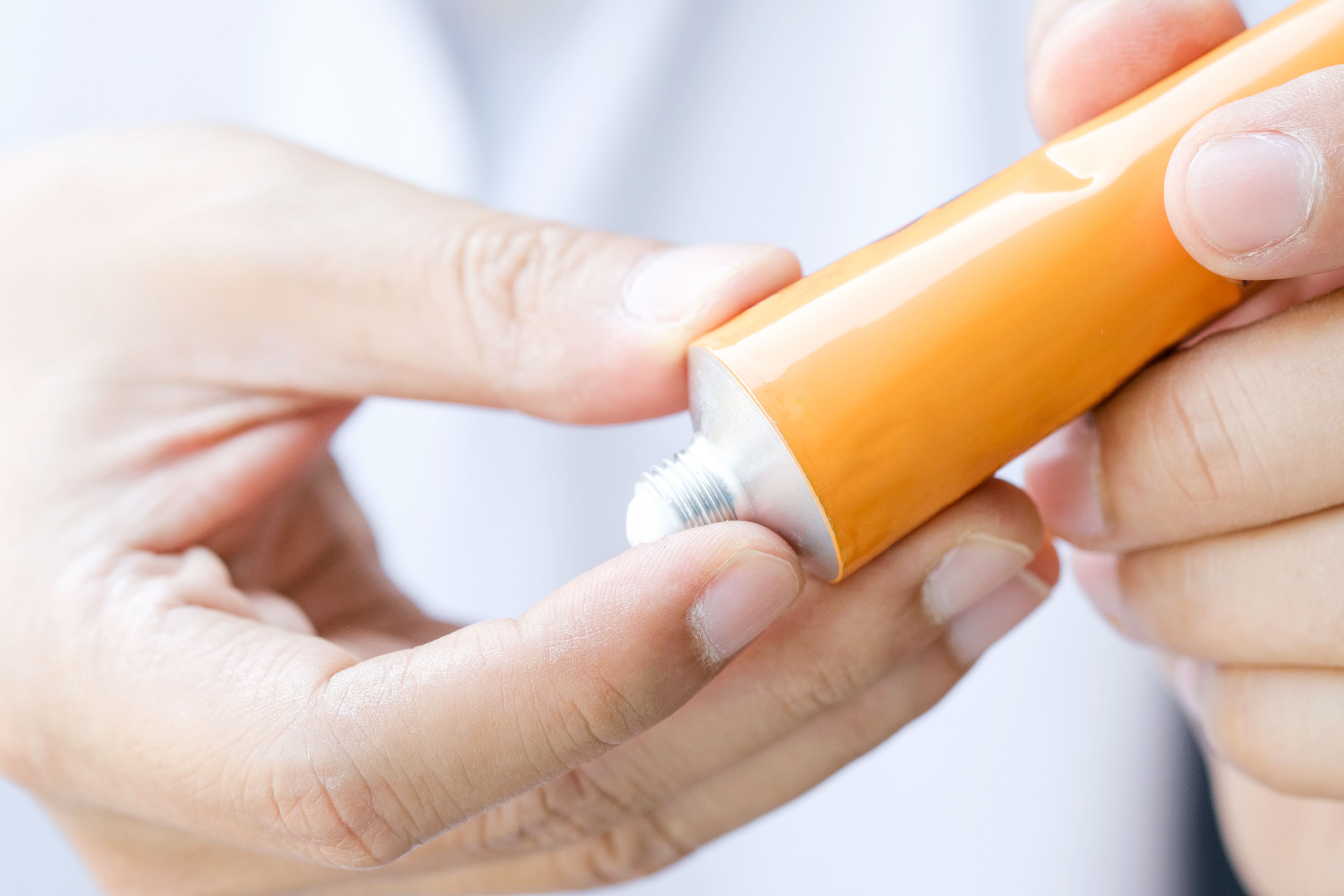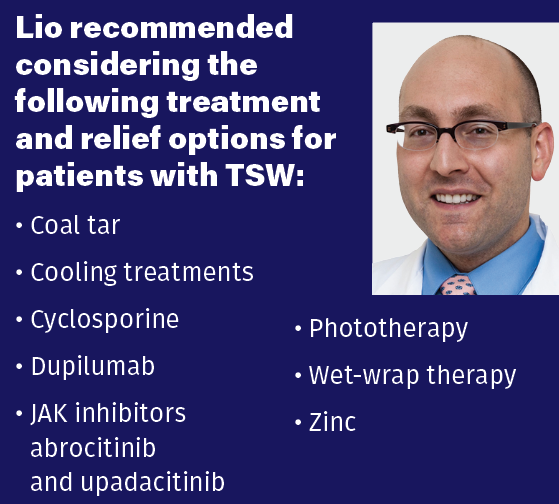
- Case-Based Roundtable
- General Dermatology
- Eczema
- Chronic Hand Eczema
- Alopecia
- Aesthetics
- Vitiligo
- COVID-19
- Actinic Keratosis
- Precision Medicine and Biologics
- Rare Disease
- Wound Care
- Rosacea
- Psoriasis
- Psoriatic Arthritis
- Atopic Dermatitis
- Melasma
- NP and PA
- Skin Cancer
- Hidradenitis Suppurativa
- Drug Watch
- Pigmentary Disorders
- Acne
- Pediatric Dermatology
- Practice Management
- Prurigo Nodularis
- Buy-and-Bill
News
Article
Dermatology Times
Navigating Topical Steroid Withdrawal and Extreme Adverse Reactions to Corticosteroids
Author(s):
Peter Lio, MD, offers perspectives on topical steroid withdrawal, also known as red skin syndrome or topical steroid addiction.
As more topical treatments have entered the dermatology space over the years,1 topical steroid withdrawal (TSW), also known as red skin syndrome or topical steroid addiction, has led to widespread discussions about the potential implications of the prolonged use of topical corticosteroids.
Despite the tremendous impact of TSW, little is known about the effects of TSW, including how frequently it arises in patients, and there is limited research2 exploring this multifaceted and extreme corticosteroid reaction.
Photo Sesaon/Adobe Stock

Understanding TSW
TSW, which can be painful and debilitating in nature, can lead to burning, erythema, flaking, swelling, thinning, and wrinkling of the skin. Nodules, papules, and pus-filled bumps, which are susceptible to oozing, can occur. Aside from physical components of TSW, patients may also experience depression, fatigue, hair loss, insomnia, and shivering.2
In fact, this burden of morbidity is often compounded by dismissal from health care providers. An April 2023 retrospective review examined the implications of TSW symptomology, management, and patient impacts. As a result, many patients reported being dismissed by dermatology providers.3
Prevention Best Practices
Peter Lio, MD, is a clinical assistant professor of dermatology and pediatrics at Northwestern University Feinberg School of Medicine and the founding director of the Chicago Integrative Eczema Center.
“I think the first thing is just basic, well-accepted, sensible use of the medicines,” Lio said. “I truly think that a lot of the people that I look to and trust that I think are great clinicians. Some of them have said, ‘I really don’t see this condition,’ and my interpretation is not that they’re lying, or that they’re trying to deceive anybody, but that literally, if you do a really good job with steroids, and you’re paying attention, this should be really, really rare.”
According to Lio, most cases of TSW tend to happen when patients make changes to their topical steroid routine, such as repeated refills or increased quantities and potencies. However, Lio said the discussion has now turned to the possibility of small amounts of topical steroids leading to the development of TSW.
“I do have patients who really have not used a lot—in my opinion, haven’t overused [topical steroids]—but really do appear to have this TSW syndrome,” Lio said.
Management Strategies
If a patient presents with TSW, Lio said the primary concern should be trusting and listening.
“I think some of the best things we can do are very much the same things we would do for eczema, atopic dermatitis, without steroids,” Lio said.

Patient Support and Education
When it comes to education on TSW, the relationship between provider and patient understandings of the condition almost go hand in hand. Due to the limited research and lack of consensus on the effects and diagnosis of TSW among dermatology clinicians and providers, patients are often led to seek assistance from sources online, which may not be reputable and ultimately may further exacerbate the burden of TSW.2
“One path is to just sort of try to push back and educate and say, ‘Listen, it’s unlikely. Let’s still do this.’ I think that can be reasonable in the right situation,” Lio said. “One option is to sort of roll your eyes and dismiss people. I think that’s always a bad choice. I don’t think that’s just, good medicine. That’s not a good patient-doctor relationship.”
Lio said it is important to emphasize to patients that in the treatment of dermatologic conditions that there is not always one clear truth or answer. As someone who has worked closely with patients who have been affected by steroid use and overuse, Lio recommends a third approach, which entails presenting TSW education at face value.
“I tend to say: ‘Listen, even if we don’t think that’s what’s going on now, I can work with you,’” Lio said. “Thankfully, I feel very lucky that we now have a whole host of nonsteroidal treatments. So I can say, ‘All right, let’s assume you have it or [are] at risk for it. Let’s just avoid steroids as best we can.’”
In some instances, such as life-threatening anaphylaxis or vasculitis in response to nonsteroidal options, Lio said it is important to inform patients ahead of time that a steroid treatment may be necessary. However, it is equally as important to emphasize that this is not always an absolute contraindication and that nonsteroidal options can still be potential options for treatment in the future.
Future Directions
Currently, there is no consistent diagnostic criteria applicable for the clinical diagnosis of TSW.1
“Part of the problem is that we don’t have a great diagnostic criteria. It’s like we don’t really have a ICD [International Classification of Diseases] code for it. We don’t have criteria, and I’ve been working on that,” Lio said.
Moving toward the future, Lio said that growing patient understanding of TSW is likely to pave the way for future consensus and guidance for the condition.
“Most of the patients I see, unlike anything else I’ve seen in dermatology, almost all the patients with TSW come in telling me they have TSW,” he said. “I think it’s fascinating, I think it’s worth thinking about together.”
References
- Mehta AB, Nadkarni NJ, Patil SP, Godse KV, Gautam M, Agarwal S. Topical corticosteroids in dermatology. Indian J Dermatol Venereol Leprol. 2016;82(4):371-378. doi:10.4103/0378-6323.178903
- Ballard A. TSW: what the eczema community needs to know. National Eczema Association. August 24, 2022. Updated August 31, 2022. Accessed August 14, 2023. https://nationaleczema.org/blog/tsw-need-to-know/#:~:text=The%20potentially%20debilitating%20symptoms%20of,%2C%20fatigue%2C%20depression%20and%20disability
- Brookes TS, Barlow R, Mohandas P, Bewley A. Topical steroid withdrawal: an emerging clinical problem. Published online April 29, 2023. Clin Exp Dermatol. doi:10.1093/ced/llad161

2 Commerce Drive
Cranbury, NJ 08512
All rights reserved.





